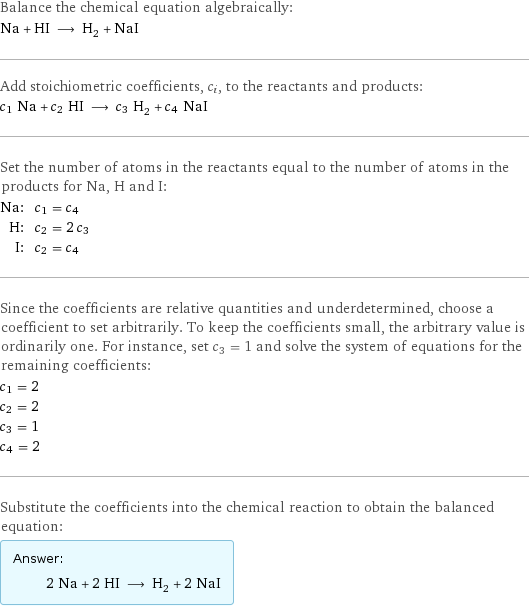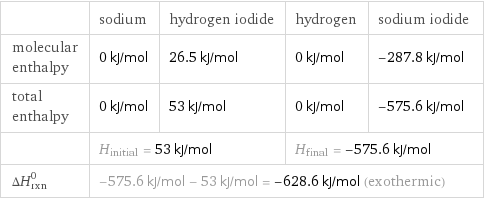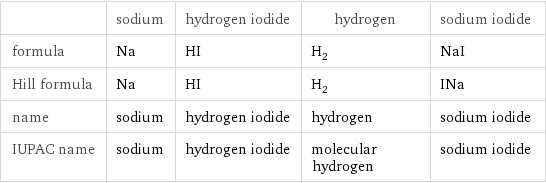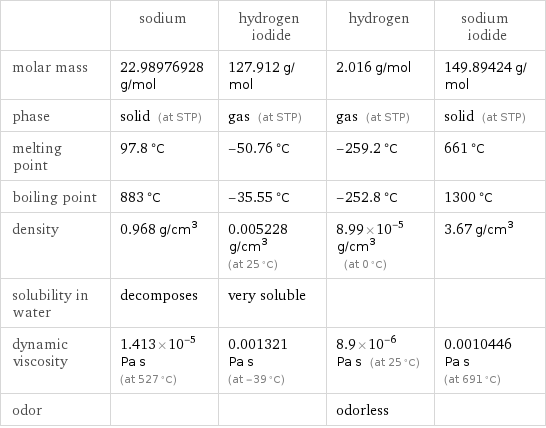Input interpretation

Na sodium + HI hydrogen iodide ⟶ H_2 hydrogen + NaI sodium iodide
Balanced equation

Balance the chemical equation algebraically: Na + HI ⟶ H_2 + NaI Add stoichiometric coefficients, c_i, to the reactants and products: c_1 Na + c_2 HI ⟶ c_3 H_2 + c_4 NaI Set the number of atoms in the reactants equal to the number of atoms in the products for Na, H and I: Na: | c_1 = c_4 H: | c_2 = 2 c_3 I: | c_2 = c_4 Since the coefficients are relative quantities and underdetermined, choose a coefficient to set arbitrarily. To keep the coefficients small, the arbitrary value is ordinarily one. For instance, set c_3 = 1 and solve the system of equations for the remaining coefficients: c_1 = 2 c_2 = 2 c_3 = 1 c_4 = 2 Substitute the coefficients into the chemical reaction to obtain the balanced equation: Answer: | | 2 Na + 2 HI ⟶ H_2 + 2 NaI
Structures

+ ⟶ +
Names

sodium + hydrogen iodide ⟶ hydrogen + sodium iodide
Reaction thermodynamics
Enthalpy

| sodium | hydrogen iodide | hydrogen | sodium iodide molecular enthalpy | 0 kJ/mol | 26.5 kJ/mol | 0 kJ/mol | -287.8 kJ/mol total enthalpy | 0 kJ/mol | 53 kJ/mol | 0 kJ/mol | -575.6 kJ/mol | H_initial = 53 kJ/mol | | H_final = -575.6 kJ/mol | ΔH_rxn^0 | -575.6 kJ/mol - 53 kJ/mol = -628.6 kJ/mol (exothermic) | | |
Equilibrium constant
![Construct the equilibrium constant, K, expression for: Na + HI ⟶ H_2 + NaI Plan: • Balance the chemical equation. • Determine the stoichiometric numbers. • Assemble the activity expression for each chemical species. • Use the activity expressions to build the equilibrium constant expression. Write the balanced chemical equation: 2 Na + 2 HI ⟶ H_2 + 2 NaI Assign stoichiometric numbers, ν_i, using the stoichiometric coefficients, c_i, from the balanced chemical equation in the following manner: ν_i = -c_i for reactants and ν_i = c_i for products: chemical species | c_i | ν_i Na | 2 | -2 HI | 2 | -2 H_2 | 1 | 1 NaI | 2 | 2 Assemble the activity expressions accounting for the state of matter and ν_i: chemical species | c_i | ν_i | activity expression Na | 2 | -2 | ([Na])^(-2) HI | 2 | -2 | ([HI])^(-2) H_2 | 1 | 1 | [H2] NaI | 2 | 2 | ([NaI])^2 The equilibrium constant symbol in the concentration basis is: K_c Mulitply the activity expressions to arrive at the K_c expression: Answer: | | K_c = ([Na])^(-2) ([HI])^(-2) [H2] ([NaI])^2 = ([H2] ([NaI])^2)/(([Na])^2 ([HI])^2)](../image_source/a2924171c2b4e528a03f91afbcf64dc4.png)
Construct the equilibrium constant, K, expression for: Na + HI ⟶ H_2 + NaI Plan: • Balance the chemical equation. • Determine the stoichiometric numbers. • Assemble the activity expression for each chemical species. • Use the activity expressions to build the equilibrium constant expression. Write the balanced chemical equation: 2 Na + 2 HI ⟶ H_2 + 2 NaI Assign stoichiometric numbers, ν_i, using the stoichiometric coefficients, c_i, from the balanced chemical equation in the following manner: ν_i = -c_i for reactants and ν_i = c_i for products: chemical species | c_i | ν_i Na | 2 | -2 HI | 2 | -2 H_2 | 1 | 1 NaI | 2 | 2 Assemble the activity expressions accounting for the state of matter and ν_i: chemical species | c_i | ν_i | activity expression Na | 2 | -2 | ([Na])^(-2) HI | 2 | -2 | ([HI])^(-2) H_2 | 1 | 1 | [H2] NaI | 2 | 2 | ([NaI])^2 The equilibrium constant symbol in the concentration basis is: K_c Mulitply the activity expressions to arrive at the K_c expression: Answer: | | K_c = ([Na])^(-2) ([HI])^(-2) [H2] ([NaI])^2 = ([H2] ([NaI])^2)/(([Na])^2 ([HI])^2)
Rate of reaction
![Construct the rate of reaction expression for: Na + HI ⟶ H_2 + NaI Plan: • Balance the chemical equation. • Determine the stoichiometric numbers. • Assemble the rate term for each chemical species. • Write the rate of reaction expression. Write the balanced chemical equation: 2 Na + 2 HI ⟶ H_2 + 2 NaI Assign stoichiometric numbers, ν_i, using the stoichiometric coefficients, c_i, from the balanced chemical equation in the following manner: ν_i = -c_i for reactants and ν_i = c_i for products: chemical species | c_i | ν_i Na | 2 | -2 HI | 2 | -2 H_2 | 1 | 1 NaI | 2 | 2 The rate term for each chemical species, B_i, is 1/ν_i(Δ[B_i])/(Δt) where [B_i] is the amount concentration and t is time: chemical species | c_i | ν_i | rate term Na | 2 | -2 | -1/2 (Δ[Na])/(Δt) HI | 2 | -2 | -1/2 (Δ[HI])/(Δt) H_2 | 1 | 1 | (Δ[H2])/(Δt) NaI | 2 | 2 | 1/2 (Δ[NaI])/(Δt) (for infinitesimal rate of change, replace Δ with d) Set the rate terms equal to each other to arrive at the rate expression: Answer: | | rate = -1/2 (Δ[Na])/(Δt) = -1/2 (Δ[HI])/(Δt) = (Δ[H2])/(Δt) = 1/2 (Δ[NaI])/(Δt) (assuming constant volume and no accumulation of intermediates or side products)](../image_source/69a1964ed976a0c1fead988166beefec.png)
Construct the rate of reaction expression for: Na + HI ⟶ H_2 + NaI Plan: • Balance the chemical equation. • Determine the stoichiometric numbers. • Assemble the rate term for each chemical species. • Write the rate of reaction expression. Write the balanced chemical equation: 2 Na + 2 HI ⟶ H_2 + 2 NaI Assign stoichiometric numbers, ν_i, using the stoichiometric coefficients, c_i, from the balanced chemical equation in the following manner: ν_i = -c_i for reactants and ν_i = c_i for products: chemical species | c_i | ν_i Na | 2 | -2 HI | 2 | -2 H_2 | 1 | 1 NaI | 2 | 2 The rate term for each chemical species, B_i, is 1/ν_i(Δ[B_i])/(Δt) where [B_i] is the amount concentration and t is time: chemical species | c_i | ν_i | rate term Na | 2 | -2 | -1/2 (Δ[Na])/(Δt) HI | 2 | -2 | -1/2 (Δ[HI])/(Δt) H_2 | 1 | 1 | (Δ[H2])/(Δt) NaI | 2 | 2 | 1/2 (Δ[NaI])/(Δt) (for infinitesimal rate of change, replace Δ with d) Set the rate terms equal to each other to arrive at the rate expression: Answer: | | rate = -1/2 (Δ[Na])/(Δt) = -1/2 (Δ[HI])/(Δt) = (Δ[H2])/(Δt) = 1/2 (Δ[NaI])/(Δt) (assuming constant volume and no accumulation of intermediates or side products)
Chemical names and formulas

| sodium | hydrogen iodide | hydrogen | sodium iodide formula | Na | HI | H_2 | NaI Hill formula | Na | HI | H_2 | INa name | sodium | hydrogen iodide | hydrogen | sodium iodide IUPAC name | sodium | hydrogen iodide | molecular hydrogen | sodium iodide
Substance properties

| sodium | hydrogen iodide | hydrogen | sodium iodide molar mass | 22.98976928 g/mol | 127.912 g/mol | 2.016 g/mol | 149.89424 g/mol phase | solid (at STP) | gas (at STP) | gas (at STP) | solid (at STP) melting point | 97.8 °C | -50.76 °C | -259.2 °C | 661 °C boiling point | 883 °C | -35.55 °C | -252.8 °C | 1300 °C density | 0.968 g/cm^3 | 0.005228 g/cm^3 (at 25 °C) | 8.99×10^-5 g/cm^3 (at 0 °C) | 3.67 g/cm^3 solubility in water | decomposes | very soluble | | dynamic viscosity | 1.413×10^-5 Pa s (at 527 °C) | 0.001321 Pa s (at -39 °C) | 8.9×10^-6 Pa s (at 25 °C) | 0.0010446 Pa s (at 691 °C) odor | | | odorless |
Units
